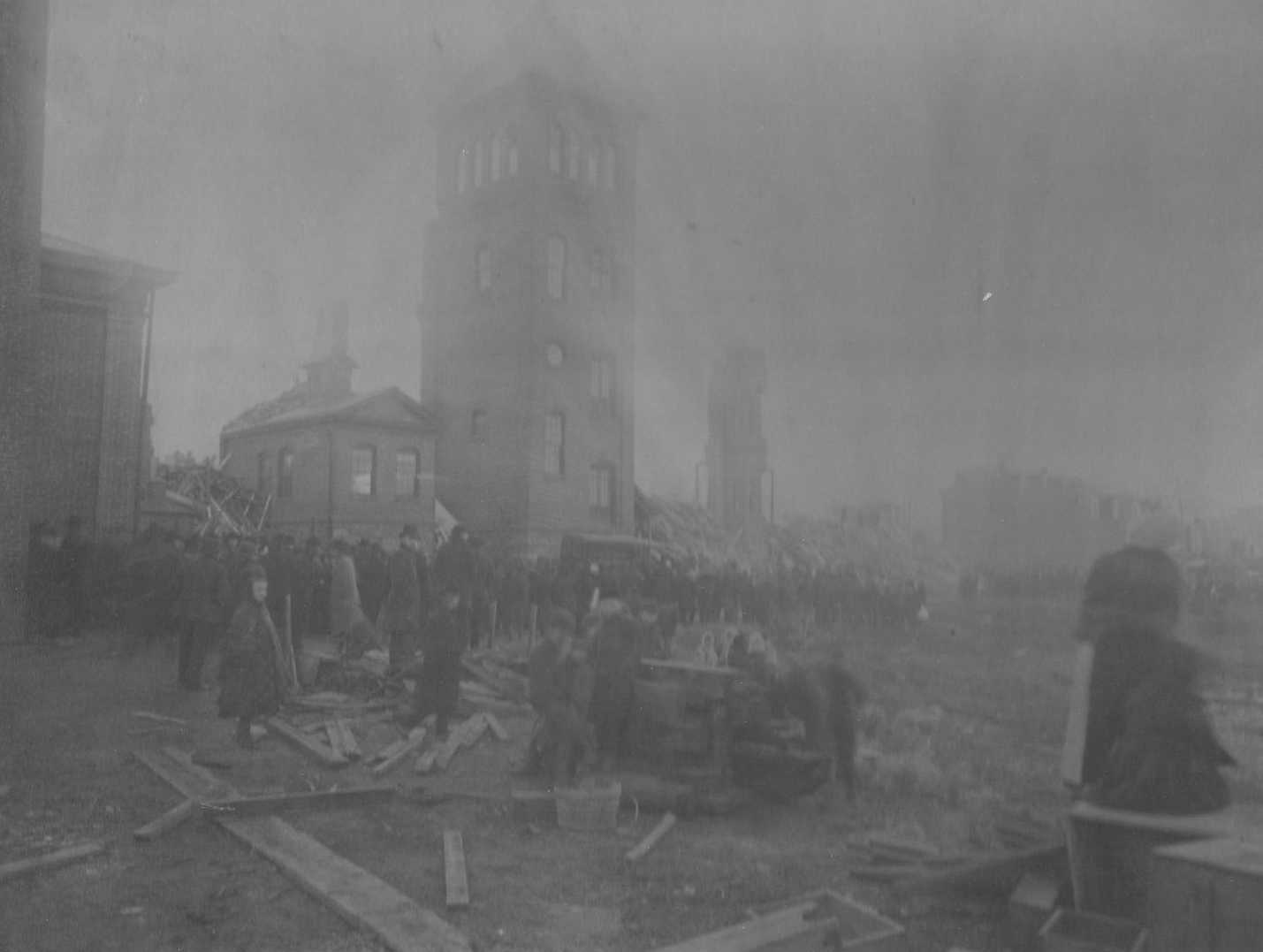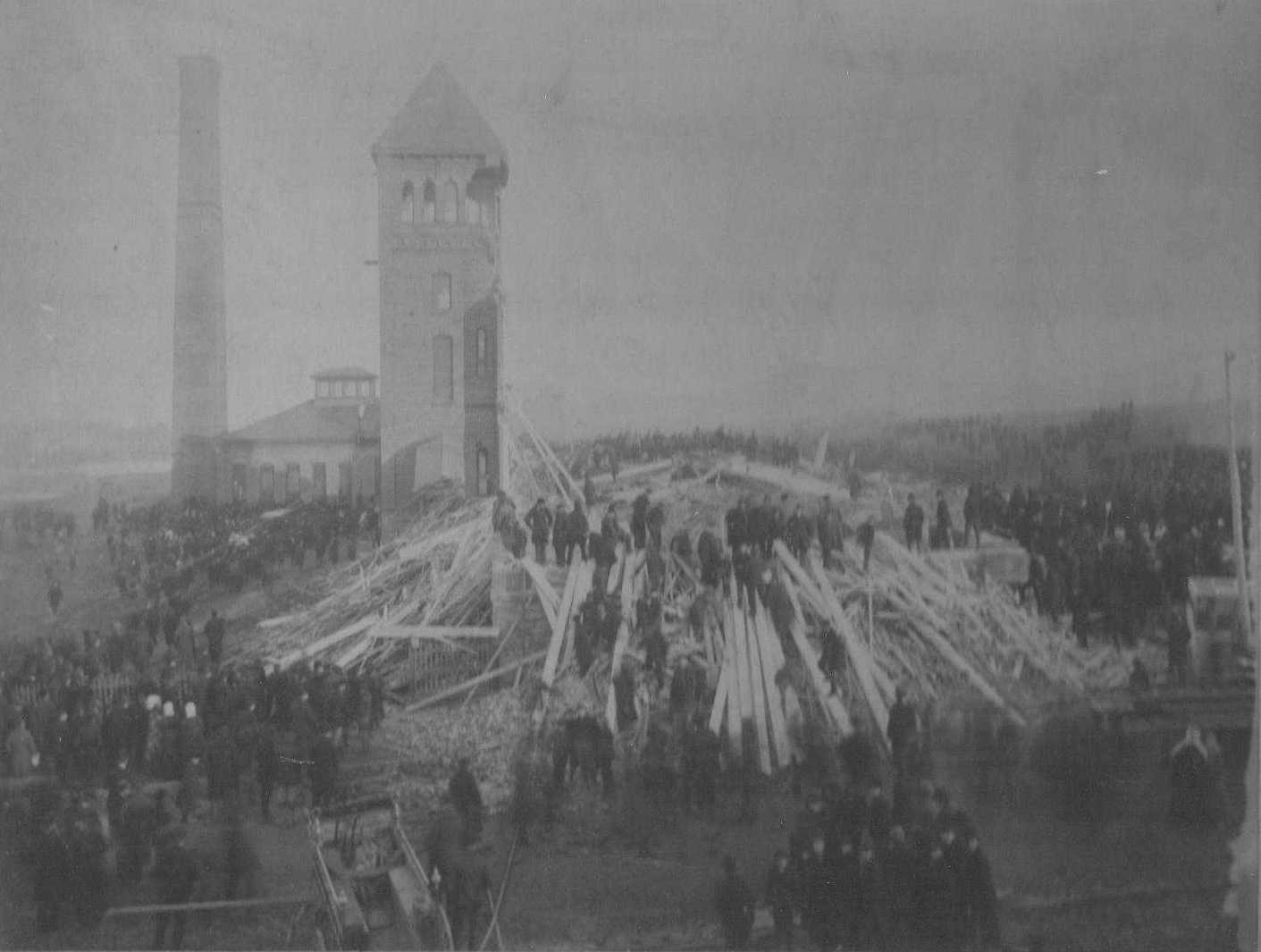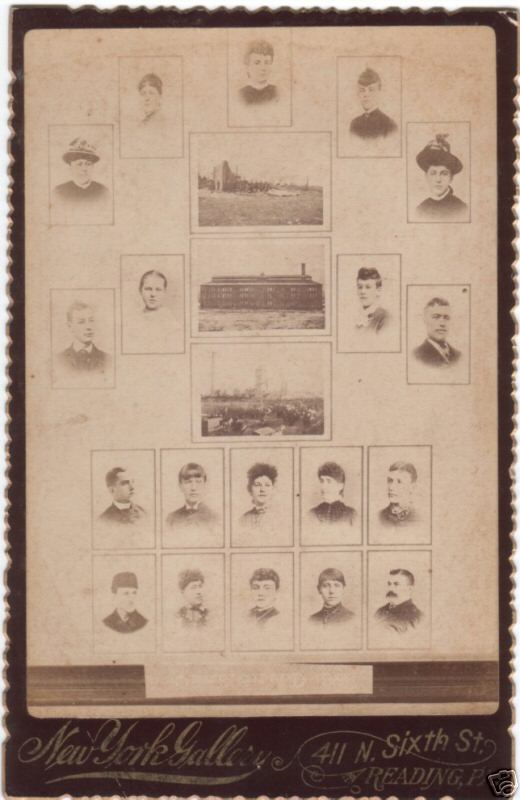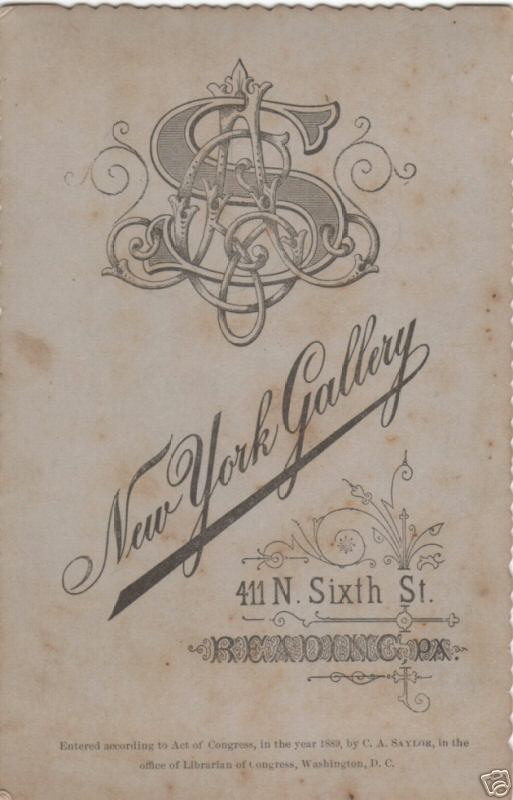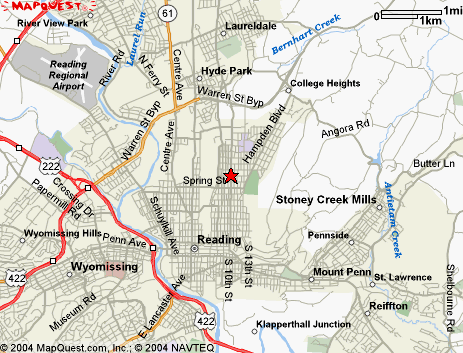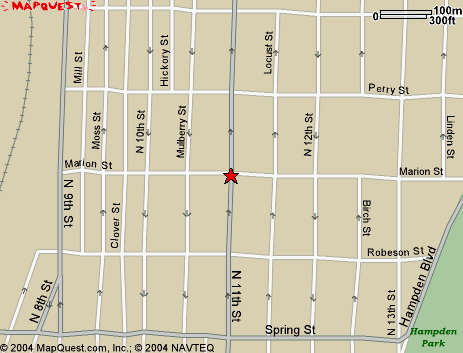Grimshaw Silk Mill, Reading, Pennsylvania
Built in 1887, Destroyed by a Tornado in 1889, Rebuilt and Operated until 1908
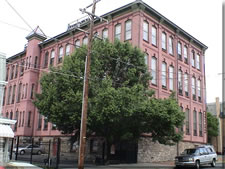
Grimshaw Silk Mill Today Source: http://www.mmgapts.com/silkmill.htm
The successful Grimshaw Brothers Silk Company of Paterson, New Jersey (see companion webpage) expanded their operations to Reading, Pennsylvania, about 125 miles away, in 1887. The Reading mill was built by L.H. Focht & Son at the expense of the city fathers of Reading and then, by prior arrangement, leased (with option to buy) to the Grimshaw Brothers Company. It was demolished by the worst storm in Reading’s history in 1889 with the loss of 17 lives, but was re-built within a year and operated for almost another 20 years until the Company discontinued operations due to financial difficulties. Today the mill is on the National Register of Historical Sites and has been renovated as an apartment building. It is still known by its original moniker, the Grimshaw Silk Mill.
Contents
Historical Account of the Origin, Destruction, and Rebuilding of the Silk Mill
Additional Information on the Grimshaw Silk Mill from Founders’ Biographies
Grimshaw Silk Mill is Now a National Historic Place
Grimshaw Silk Mill Has Been Renovated As An Apartment Building
Commemorative Card on the Destruction of the Mill
Webpage Credits
Thanks go to Marge Tamboer for providing the photos of the destroyed mill that appear on this webpage.
Historical Account of the Origin, Destruction, and Rebuilding of the Silk Mill
The pertinent information on the origins of the Grimshaw Silk Mill is provided in the “History of Berks County1” by Morton Montgomery. The entry under “Silk” also describes the destruction and rebuilding of the mill and is shown below:
SILK
GRIMSHAW Mill. In the year 1887, John, George and David GRIMSHAW, trading as GRIMSHAW Brothers, came from Paterson, N. J., for the purpose of establishing a silk-mill at Reading and operating it in connection with their large plant at that place, if properly encouraged in their proposed enterprise. In this behalf, a number of public-spirited citizens organized an association and secured subscriptions, amounting to $65,000. The building committee comprised Henry EPPIHIMER, George D. STITZEL, Lewis KREMP, Jerome L. BOYER and William ROSENTHAL, who purchased a half-block of ground at Eleventh and Marion streets and erected a superior three-story brick structure 50 by 250 feet and leased it for a term of years, with an option to purchase, to the GRIMSHAW Brothers, who then equipped it with machinery for the manufacture of silk, costing about $75,000.
They carried on the mill successfully until Jan 1, 1908. Producing large quantities of dress goods, linings, thrown silk, and yarns, which were shipped to New York. Then they became an incorporated body, trading under the name of GRIMSHAW Brothers Company, and the plant was transferred to this company which has since operated it, employing from 300 to 400 hands, mostly girls. The officials of the company are: John GRIMSHAW, president; David H. GRIMSHAW, treasurer; and George GRIMSHAW, secretary.
On Jan 9, 1889, the building was blown down by a tornado, the most destructive storm that ever visited Reading. The mill was in full operation at the time. Many of the hands escaped, but 17 were killed and over 100 injured. A public meeting of citizens assembled in the Court-House on Jan. 10th for supplying aid to the suffering families, and altogether $12,000 was received from the people of Reading and elsewhere, which was judiciously distributed by a committee appointed for that purpose.
Source: http://www.rootsweb.com/~paberks/library/business/s-u.html
Figure 1 shows two photos of the mill shortly after it was destroyed by the cyclone in January 1889.
Figure 1. Two photos of Grimshaw Brothers Silk Mill, apparently taken shortly after the mill was hit by the tornado. Thanks go to Marge Tamboer for providing these photos; she obtained them from her father, Leonard M. Tamboer, who got them from Jessie Farrar Boonstra, daughter of Emma Grimshaw Farrar. Jessie got them from Emma, who received them from Alfred Grimshaw, Emma’s brother! Alfred Grimshaw was the son of James Grimshaw and Mary (unknown) and was therefore a cousin of the four brothers who operated the Grimshaw Silk Mill in Reading.
The Fresno Weekly Republican2 carried the following account of the tornado, apparently from an Associated Press reporter, on page 1 of its January 11, 1889 edition. Coverage of the Grimshaw Silk Mill destruction is shown in bold for emphasis.
A HURRICANE.
Hundreds of People Hurled into Eternity.
Nothing Stayed Its Wrath, and the Worst Is Not Told.
The Velocity of the Wind Exceeded a Hundred Miles an Hour- Wires Down; News Coming Slowly.
Reading, Pa., January 9. – A cyclone passed over this city this evening, doing considerable damage and killing more than fifty people. This was the saddest night in the history of Reading. A hundred families are in mourning as a result of to-days calamity. The cyclone went over the northern section of the city this afternoon and laid in waste everything in its reach. At 10 oclock to-night it is estimated that not less than sixty persons have been killed outright and over one hundred injured. The rainfall, which continued all morning, ceased during the afternoon, and by half-past 4 oclock the sun made an effort to penetrate the clouds, when suddenly the sky changed and with appalling rapidity the storm was seen coming from the west, cutting a swath 200 feet wide and spreading destruction. In the country, farmhouses were unroofed, buildings blown down and the crops uprooted. In Reading the Mount Penn stove works, J.S. Hornbergs rolling-mill and a number of dwellings were at once wholly or partially unroofed, and a passenger car of the Reading railroad companys track was blown into splinters. In the meantime the rain was falling in torrents and it was almost as dark as night.
The work of rescue was continued all the afternoon, and up to 10 oclock fifty mangled and bruised bodies were taken from the ruins. Seven were dead and others dying, and many fatally injured. It is believed that the list of the dead will be greatly increased before morning, as a number of persons are known to be still under the debris. Those identified up to 11 oclock are: Samuel Stringer, Thomas Jones, Charles Fritch, George Mason, a colored boy named Targge and George Kirch. The inspector of the police stated, at late hour to-night, that he was of the opinion that from fifteen to twenty-five person sere yet in the ruins, and he would not be surprised if the death list would be increased to fifteen or twenty-five persons were yet in the ruins, and he would not be surprised if the death list would be increased to fifteen or twenty. Thirty-six have been identified who are seriously injured. It is almost impossible to-night to give a reliable estimate of the pecuniary damage, but it will probably be $75,000 to $100,000 in the immediate vicinity of the wrecked buildings. The cyclone wrought terrible destruction in other parts of the city and out along the railroads centering here. A portion of the foundry of McIntosh, Memphill & Co., was also blown down. The paint shops of the railroad company, in which were thirty men employed in painting passenger cars, were struck by the storm and bricks flew in every direction. The cars were turned topsy turvey and the men buried under the debris. The gas in the cars exploded like the sound of musketry, causing the people in the neighborhood to rush out of their houses. There was considerable gasoline in the building which added fuel to the flames that shot heavenward. All but four of the men escaped. The cries of the latter were heard for a time; then they were stilled forever. The building and cars were consumed in fifteen minutes in despite of the efforts of the fire department. The names of the dead are
John Miller, Albert Landberger, Sheridan Jones and George Schaffer. Of the other employees one had an arm broken and George Knabb is probably injured internally. The loss to the railroad company will reach $75,000. The storm traveled at the rate of almost 100 miles an hour. A dozen more private houses in the course were unroofed. Directly in its path, at the corner of Twelfth and Marion streets, stood the Reading silk mill, in which about 175 girls were working. The building was a huge, substantial structure of four stories, occupying a full block of ground, and surmounted by a massive tower fully one hundred feet from the ground. A funnel shaped storm-cloud struck the building directly in the center of the broadest side, and it fell to pieces as if composed of so many building-blocks. Nearly 200 human beings went town in the awful wreck. The wrecked walls gave way and the floors fell down on top of the other, and carried their great mass of human beings to the bottom. The bricks were piled up in the greatest confusion, while above the hurricane rose the cries for succor. From the ruins probably seventy-five or 100 girls, with blackened faces and bruised or broken limbs and torn clothing, drew themselves out or were dug out by friendly hands. These worked on upper floors. At some places the bricks ware piled up twenty feet deep, and underneath are lying to-night human bodies by the score. In response to the alarm thousands of citizens hastened to the scene, and, by the light of the bonfires, the work of rescue was commenced. The fire company left the burning railroad shops, and the entire police force was called out. The ambulance and relief [illegible word] all set to work. One young woman was brought out covered with cuts and wounds. One body was dragged out which had the head cut off. The Associated Press reporter entered what had been the basement of the building, and, groping his way through the debris sighted five bodies [illegible, about 4 words](end of page 1, column 7)
close together, all dead. They were pinned down and it was impossible to move them at the time, up to half-past 10 to-night probably the bodies of a dozen of the dead had been taken out, while the greater portion of the remainder were still buried in the ruins. All the living brought out were terribly wounded. The work of the rescue will be continued all night. The mill was operated, but not owned, by the Grimshaw Bros. of Patterson, New Jersey. They put in the machinery at a cost of $45,000, which is a dead loss. The building cost $63,000.
Sunbury, Pa., January 9. – A rain and wind storm came up suddenly this evening and blew over two of the stacks of the Sunbury nail mills. They crashed through the roof, completely demolished the puddling department of the mills. Thirty-five were employed in this department, and half of them were buried in the debris. Two of the men have been taken out dead. The wounded so far recovered number nine.
Pittsburgh, Pa., January 9. – The storm which did such damage here also demolished considerable property at Alleghany, Halls station, Wihnerding, McKeesport and other places. The boats on the rivers were cast adrift like corks, but were secured before much damage was done. The velocity of the wind was over fifty miles an hour.
Reading, Pa., January 10. – The five men who were burned to death in the railroad paint shops during the hurricane have been identified, as have also twenty-eight dead at the ruins of the silk mill. The number of injured so far accounted for in the latter disaster is 117, many of whom are expected to die. This afternoon a largely-attended meeting of citizens was held in the courthouse and over $5000 was subscribed for the relief of the destitute. Any amount needed was promised. The entire city will be canvassed for funds. The work of hunting for the dead was continued all of to-day and will be carried on through the night. Over thirty dead are still missing, and probably a dozen more of the missing are still beneath the debris. The coroner on to-morrow will begin an inquest on the bodies of the five men roasted to death in the Reading shops, but will hold no inquest on the silk men bodies until satisfied that they are all taken out of the ruins. Very little business was done in the city to-day. At midnight the seventeenth body, that of Charles McKee Owen, was found in the rear of Welding store. It is thought that the remaining bodies will be secured before morning.
Later. – Two more bodies were found in the ruins at 1:30 oclock this morning.
Additional Information on the Grimshaw Silk Mill from Founders’ Biographies
More detail on the Grimshaw Silk Mill is found in the biographies of two of the Grimshaw Silk Company founders – George and David Grimshaw. These biographies appear in the “History of Paterson and Its Environs3.” David’s biography is given first (p. 302), with information on the Reading mill shown in bold:
DAVID H. GRIMSHAW – The Grimshaw family has figured prominently in the life and affairs of Paterson for many years. One of the oldest members of the silk industry in the city is David H. Grimshaw, who has since the inception of his business career been identified with this particular industry.
David H. Grimshaw was born in Macclesfield, England, the son of George and Mary (Barnes) Grimshaw. He attended the schools of his native place until he was fourteen years of age, and during this time in his spare hours ran hand looms that were installed in his fathers home. At the tender age of fourteen he came to this country, and upon landing in New York City came direct to Paterson, N.J., where his business career had its inception by his becoming a weaver in several of the local mills. In 1872, together with his brothers, James, John and George, who had also come to this country when very young, he formed the Grimshaw Brothers, silk manufacturers, locating first at No. 72 Pearl street, later removing to a mill at the corner of Spruce and Market streets, where they remained for three years, subsequently going to the Arkwright Mill. Four years later the brothers purchased the Greppo Mill on Dale avenue, and also had a large mill at Reading, Pa. The brothers enjoyed remarkable success, the business increasing until it occupied an important place in the industrial world. In 1908, however, the concern failed and then David H. Grimshaw founded the D.H. Grimshaw Company, silk throwing, in which he still continues at No. 436 Graham avenue. His affiliations are with the Ivanhoe Lodge, no. 88, Free and Accepted Masons. He resides at No. 426 Park avenue.
David H. Grimshaw is a man eminently respected in Paterson. Although he displays a deep interest in the welfare of the community which has been his home for so many years, he has remained aloof from public and political life. A man of magnetic personality, possessing the gift of making and holding friendships, he stands high in the regard of all who are acquainted with him.
Mr. Grimshaw married Mary Irving, and they were the parents of twelve children, nine of whom survive.
George Grimshaw’s biography is given on page 474 of the same publication; the information on the Reading Mill is again shown in bold:
GEORGE GRIMSHAW, a member of the older generation of silk manufacturers in Paterson, was born Jan. 6, 1852, at Macclesfield, England, the son of George B. and Mary (Barnes) Grimshaw. George B. Grimshaw was born in Lancashire, England, and was brought by his parents to Macclesfield when he was but two years old. He resided here throughout his entire lifetime, and was engaged in the silk industry until his retirement from active business life, which occurred within a few years previous to his death.
The education of George Grimshaw was obtained in the public schools of his native place, after which the business of life began for the boy and he secured employment in Bockmans Woolen Mill. In 1868 he came to this country, and upon landing in New York City, came immediately to Paterson, N.J., where he entered the silk mill of the William Strange Company, subsequently entering the Phoenix Mill, where he remained until, with his brothers, he formed the firm of Grimshaw Brothers and was located at No. 72 Pearl street, Paterson. The enterprise, starting in a small way, quickly flourished and soon outgrew its quarters which necessitated moving to a larger mill at Grand and Spruce streets in the J. Booth & Companys Mill, and here they continued until some time later when the brothers bought the Grippo Mill at Dale avenue and Slater street, and changed its name to the Grimshaw Mill. At about this time they founded another plant at Reading, Pa., which was totally destroyed by a cyclone in 1889. In a years time, however, this mill was rebuilt and here the company continued until 1907 when, having met with financial reverses, they discontinued the company and George Grimshaw, with whom this review deals particularly, established himself in the manufacture of ribbons at his present location, No. 96 Dale avenue, Paterson. This venture, which has already proven highly successful, gives promise of further development. Mr. Grimshaw devoting all his resources to bringing it up to a high standard. Through the nature of his business he has ever been brought more or less before the public eye, and for many years was prominently identified with all movements which had for their end the advancement of civic interest. He has always been widely known and eminently respected in business circles throughout the community. Mr. Grimshaw affiliates with Ivanhoe Lodge, Free and Accepted Mason, and also holds membership in the Hamilton Club of Paterson.
On March 23, 1888, George Grimshaw was united in marriage with Mary Frances Leitz, daughter of Matthew and Mary Leitz. Her father was a lieutenant in the Union army during the Civil War, and now lives retired at Erie, Pa. Mr. and Mrs. Grimshaw are the parents of five children: Mary, born Jan 13, 1890; Hugh Matthew, born Feb. 26, 1892; John C., born May 24 1896; Georgiana M., born Aug 9, 1899, married Max Thompson, of Paterson, N. J.; Edward Barnes, born Nov. 25, 1905. The family home is at No. 359 Summer street, Paterson, N. J.
Together these two biographies provide valuable additional information on the origins of the silk mill in Reading
Grimshaw Silk Mill is Now a National Historic Place
The silk mill was added to the list of National Historical Sites in 1985 (Building #85000176) as a noteworthy “event” in the category of architecture/engineering. L.H. Focht was the architect (or engineer or builder), as shown in Figure 2.
Figure 2. Entry from webpage Indicating Designation of Grimshaw Silk Mill As a National Historical Site. The reference is shown below the table.
|
Grimshaw Silk Mill (added 1985 – Building – #85000176) |
||||||||||||||||||||
|
Source: http://www.nationalregisterofhistoricplaces.com/PA/Berks/state.html
The builder, L.H. Focht & Son, was at one time “the largest building and contracting firm in the city of Reading” according to the following webpage:
Grimshaw Silk Mill Has Been Renovated As An Apartment Building
The Grimshaw Silk Mill, renovated as a 41-apartment dwelling place, is nicely described by the management company on it’s website as shown in Figure 3. The modern photo of the mill at the top of this webpage is from a previous version of the management company’s webpage. Figure 3 includes a different photo of the modern Grimshaw Silk Mill apartment building from the previous webpage. Additional exterior photos and interior pictures of the apartments, as well as apartment floor plans, are provided on a companion webpage.
Figure 3. Webpage description of Grimshaw Silk Mill apartments from the management company’s website. The webpage address is given below the figure. Additional information ont he apartments from the management company website is given on a companion webpage.
 | 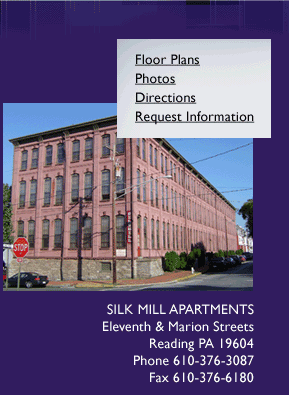 |
A Historic Rehabilitation of The Grimshaw Silk Mill at 1200 N 11th Street, Reading, PA.
Silk Mill Apartments consists of forty-one apartments, ranging from one or two bedroom units with the third floor units boasting 22 foot high ceiling loft apartments. Each apartment has sandblasted wooden beams that compliment the 18′ -22′ high ceilings, exposed brick walls, dramatically large windows that flood the rooms with natural light, and luxurious wall to wall carpeting all in an uniquely spacious layout. Additionally, each apartment is equipped with plenty of closet space, ceiling fan, window treatments, individual climate controls for heating and air conditioning, washer and dryer, Euro-style kitchen cabinetry and energy saving appliances, including a microwave, 30″ gas cooking range, refrigerator/freezer with built in ice maker, dishwasher and garbage disposal. When entering the building you are immediately impressed with the exposed brick walls, open area stairway and elevator for your convenience. There are trash rooms on each floor, a private off street parking lot, private fitness center for the exclusive use of our residents, and an apartment to lobby intercom system.
Have it all at The Silk Mill Apartments, one truly unique living spaces for truly unique people. There is nothing else like it!
KITCHEN
- Fully equipped kitchens including range and refrigerator
- 12 or 15 cu. ft. Refrigerator-Freezer with Ice Maker
- Microwave
- Garbage Disposal Dishwasher
- 30″ Gas Cooking Range
- Euro-style Kitchen Cabinetry
BATH
- One-Piece Fiberglass Tub
- Premium Quality Faucets
- Oak Vanity with One Piece Marble Top
- Medicine Cabinet
- Mirror
- Full Bath with Exhaust
ENERGY SYSTEM
- Energy-Efficient Gas Heating Units, Featuring Individually Controlled Heating Systems
- Individually Controlled Central Air Conditioning System
- Energy-Efficient 40 Gallon Electric Hot water Heaters with Timers
SECURITY SYSTEM
- Automatic Entry Control System Provides Push-Button Admittance
- Telephone Intercom System Between Each Apartment and Its Lobby
- Steel Rated Fire Doors
- Smoke Detectors in Apartments and Corridors
- Fire Alarm System and Sprinklers in Each Corridor (24-Hour Monitoring)
SPECIAL AMENITIES
- Wall-to-Walt Carpeting
- Spacious Rooms
- Lofty Ceilings
- Exposed Sandblasted Wooden Beams
- Exposed Brick Walls
- Dramatically Large Windows (with Storm Windows) Which Flood the Apartment with Natural light
- Mini Blinds For all Windows
- Ceiling Fan in living room (Grand Room)
- Private Off Street Parking
- Each Apartment Pre-Wired for Phones and Cable TV
- Washer and Dryer in Each Unit
- Spacious Closets
- Bulk storage
- Convenient Floor Trash Areas with Shoots That Lead to-a Trash Compactor
- Carpeted, Well lighted Corridors
- Fitness Workout Center
|
Corporate Offices Copyright 2005. All |
Commemorative Card on the Destruction of the Mill
A commemorative photo card was apparently published by a local photo company in Reading, the “New York Studio”, shortly after the Grimshaw Silk Mill was destroyed by the tornado. The card was offered for sale in March 2005 on eBay and was purchased for $73.00. Images of the card and its reverse side from the eBay ad are shown in Figure 4.
Figure 4. Images from eBay of photo card commemorating the destruction of the Grimshaw Silk Mill in 1889 (first image) and the studio that produced the card (second image). A description of the card appeared with the card in the eBay ad and is included below the images.
Description
|
Item Specifics – Photo Images
| ||||||
|
Dimensions (Unframed)
| ||||||
|
Width:
|
4 inches
|
Subject:
|
Historic/Vintage
| |||
|
Height:
|
6 inches
|
Color:
|
Black & White
| |||
|
Date of Creation:
|
Pre-1950
|
Framing:
|
Unframed
| |||
|
Photo Type:
|
Cabinet Photo
|
Country/Region:
|
US
| |||
|
Original/Reprint:
|
Original Print
|
If you are a collector of Reading PA memorabilia, here is an item that may cross your path one time. And in very nice condition. This very card is featured in a George M. Meiser IX Passing Scene Volume 6. A 4 page layout, one page featuring this very rare photo memento card. The following is taken from the subheading, under the photo in his book. C. A. Saylor, who operated the New York Gallery at
411 North Sixth Street, Reading, assembled this rare composite of the VICTIMS OF THE GRIMSHAW MILL DISASTER–in record time–to sell as a memento, while interest remained intense. Notice that no attempt has been made at individual identification…and 19 folks are pictured despite the fact the death toll numbered 17. END That I would think surely dates this card to near the date of occurrence. Jan. 9, 1889. When a most severe wind blew thru Reading and leveled the Silk Mill killing 17 people. I really hate to part with this card, it is a real prize to any ReadingPA collection. I will offer this card for a 10 day auction one time only. I hope my starting bid price will reflect what I think is a fair market value, especially considering the rarity. If not, back in my collection it goes, as fate may have it. S&H will be secure and $3.00. Questions are surely welcome. Remember..once in a lifetime on this rare card. Good Luck!
Where is Reading, Pennsylvania?
Reading is located in southeast Pennsylvania — northwest of Philadelphia, about half the distance to the state capital of Harrisburg. Figure 5 shows map images at several scales.
Figure 5a. Location of Reading (indicated by red star) between Philadelphia and Harrisburg, Pennsylvania. Note also the location of Paterson, New Jersey, about 125 miles northeast of Reading and not far from New York City.
Figure 5b. Location of Grimshaw Silk Mill in Reading, Pennsylvania in regional context.
Figure 5c. Location of Grimshaw Silk Mill at corner of 11th Street and Marion Street. From the photos on this webpage, it appears that the mill occupies most (if not all) of the west half of the block bounded by Marion, Locust, Perry and 11th Streets.
References
1Montgomery, ML, 1886, History of Berks County in Pennsylvania: Philadelphia, PA, Everts, Peck & Richards, 1204 p.
2Author Unknown, 1889, A Hurricane – Hundreds of People Hurled into Eternity – Nothing Stayed Its Wrath, and the Worst Is Not Told – The Velocity of the Wind Exceeded a Hundred Miles an Hour – Wires Down; News Coming Slowly: Fresno, CA, The Fresno Weekly Republican, v. 13, no 15 (January 11, 1889), p. 1, col. 7-8.
3Nelson, William and Charles Shriner, 1920, History of Paterson and Its Environs (The Silk City) – Historical, Genealogical, Biographical: New York, NY and Chicago, IL, Lewis Historical Publishing Company, v. III, unk p.
Other Potential Sources:
Montgomery, ML, 1898, History of History of Reading, Pennsylvania, and the Anniversary Proceedings of the Sesqui-centennial, June 5-12, 1898: Reading, PA., Times Book Print, 298 p.
Montgomery, ML, 1909, Historical and Biographical Annals of Berks County, Pennsylvania, Embracing a Concise History of the County and a Genealogical and Biographical Record of Representative Families: Chicago, IL, J.H. Beers & Co., 2 v.
Webpage History
Webpage posted March 2005.
